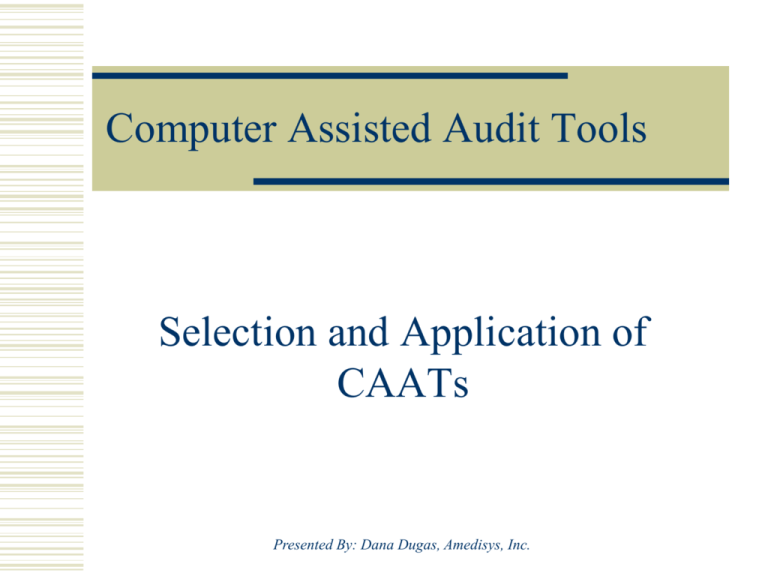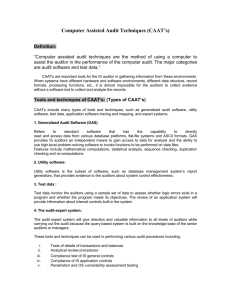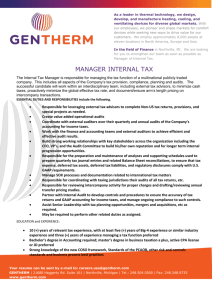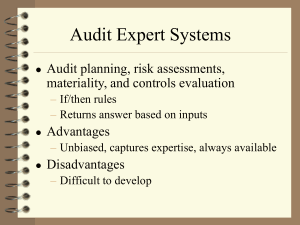Computer Assisted Audit Tools
advertisement

Computer Assisted Audit Tools Selection and Application of CAATs Presented By: Dana Dugas, Amedisys, Inc. Today’s Environment Internal Auditors are advising organizations on internal control attributes and ways to gain assurance from information. SOX compliance efforts have led companies to delve more deeply into their financial statement reporting elements and into the data that feeds and supports the financial data. Today’s Environment Internal Audit groups faced with growing workloads and heightened accountability Discovering that Computer Assisted Auditing Tools (CAATs) offer much needed help Audit technology tools facilitate more granular analysis of data and help to determine the accuracy of the information CAATs- Review 100% of data Comprehensive approach of testing contrasts with traditional audit sampling methods (extracting small data sets and extrapolating conclusions about the population of transactions) Sampling techniques require audit judgment and confidence levels; whereas CAATs deliver more definitive results because the entire population of data can be tested CAATs- Review 100% of data Filtering large volumes of data is much more practical and effective Work with greater quantities of data Work with data that is more complex Ability to identify financial leakage, policy noncompliance, and mistakes or errors in data processing For example: duplicate vendor payments; fraudulent transactions, circumvention of invoice approval limits Tool selection The challenge Make sure you are looking at the right tools to deliver the benefits your company needs It is the user’s responsibility to become familiar with the tools available in order to pick the right one Have a solid knowledge of your business, your data, and the accounting practices in your industry Tool selection The IIA conducted an audit software analysis and reported several key recommendations for internal auditors to consider in the selection of CAATs: 1. 2. 3. 4. Determine the enterprise’s audit mission, objectives and priorities Determine the types and scope of audits Consider the enterprise’s technology environment Be aware of the risks 1. Determine the enterprise’s audit mission, objectives and priorities Auditors must consult with management regarding what audit functions are of the highest priority and where computer audit tools may be applied to help meet those priorities. 2. Determine the types and scope of audits What is the stated objective of the audits? What kinds of questions will auditors be asking and what will be the boundaries? Arriving at answers to these questions will be critical in making an appropriate software decision. 3. Consider the enterprise’s technology environment Any audit tools selected will have to mesh with the other software, hardware and network systems already in place. In some cases, the existing IT infrastructure may incorporate tools that auditors can use in concert with automated software tools for improved effect. 4. Be aware of the risks Applying software to any mission-critical function carries some risks, and auditing software is no different. Automated software tools can prompt auditors to jump to faulty conclusions or make assumptions that run counter to enterprise operations. Tool Selection Consider: How many data sources you have Volume of transactions Characteristics to look for in CAATs: Ease of use Ease of data extraction Ability to access a wide variety of data files from different platforms Ability to integrate data with different format Ability to define fields and select from standard formats Menu-driven functionality for processing analysis commands Simplified query building and adjustments Logging features Audit data analysis techniques Execute tests for virtually all industries and almost all types of data: Accounts Receivable Payroll Cash Disbursements Purchasing Sales General Ledger Work in Progress Loss Prevention Asset Management Limiting factors: Access to data Understanding of the data fields Creativity of the auditor ACL (Generalized Audit Software) Data is locked down as read-only No chance of inadvertently changing the data Much higher risk when using spreadsheets Commands are auditor-friendly Fairly easy to grasp what the commands will do once explained Reasonably short learning curve ACL Automatically records all of the commands that are run and the results of the procedures in its log LOG feature enables automation of workpapers Export the log to a word processor or other file type ACL Batch feature (Writing Scripts) Develop audit procedures to run in ACL Auditor puts together the various routines in a batch (similar to a macro) Next time the auditor can run one command (push a button), and all of those procedures will run on autopilot with ACL dumping the results into the log Become much more efficient over time by running same tests periodically, adding new procedures to the batch Additional Keys to Success Identify a Champion- person with ability to motivate, supervise, and generally make sure the technology is employed and becomes successful General Training- for the users of the software (www.acl.com) Identify power users- given more specific training and become leaders of implementing the chosen software; assist other auditors; conduct in-house training. Audit data analysis techniques CAATs especially valuable in environments that have: High volumes of transactions Complex processes Distributed operations Unrelated applications and systems Advantage of CAATs Organizations gain assurance about the accuracy of transactional data, and the extent to which business transactions adhere to controls and comply with policies Consistent use of automated transaction analysis and continuous monitoring, CAATs enable real-time independent testing and validation of critical enterprise data. Advantage to Management Management can use such information to proactively identify exceptions to controls and compliance policies and take immediate action. Implementing these programs can lead to increased confidence in the corporate data underlying financial reporting. The End References: Selection and application of computer assisted audit tools; Mark M. Stephenson Generalized Audit Software: Effective and Efficient Tool for Today's IT Audits; Tommie Singleton Presenter Information: Dana Dugas, Amedisys, Inc. ddugas@amedisys.com 225-368-2770







